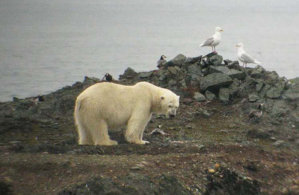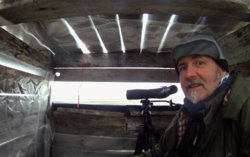Svalbard expedition confirms hungry polar bears a threat to conservation success story

A Wildfowl & Wetlands Trust (WWT) scientist just returned from Svalbard has confirmed that polar bears stranded on land in the summer months are devastating breeding barnacle goose populations as they roam the coastline looking for food.
Conservation efforts over the last 60 years have brought the goose, which migrates between Scotland and Svalbard, back from a dire 300 to over 30,000.
However, as the polar ice diminishes there has been a direct increase in the number of bears especially on the west coast of Spitsbergen and they are unable to reach the seal colonies on which they usually feed.
The entire population of Svalbard barnacle geese winter on the Solway Firth and return to breed in Svalbard each summer. Last winter only half the expected numbers of goslings were seen as the flocks returned to the Solway and reports from Svalbard indicate that the situation may be similar this winter.
This summer, WWT's Brian Morrell joined the Branta Research team from the University of Groningen as they spent eight weeks monitoring one barnacle goose colony on Diabasøya Island on the Nordenskiöldkysten. During that time they observed ten different polar bears.
The first bear ate over 1,000 eggs and the subsequent visits were equally devastating. Of over 500 nests on the island, fewer than 40 were successful and most of them had very small clutch sizes of only one or two goslings.
WWT’s Brian Morrell said: “It was heartbreaking to see the geese lose their eggs after all that time and effort, they just stood there after the bear had left looking forlornly at the nest for up to half an hour before flying off to feed.
“The geese are very long-lived birds and ironically their survival rate is increased if they don’t actually breed, especially the females. But if their breeding continues to be affected in this way the population will quickly age, which threatens its stability and the future conservation of this bird which is very special to WWT.”
WWT’s chief executive, Martin Spray, added: “It is a tragedy to witness two species of conservation concern clashing over the right to survive, and demonstrates very graphically the tensions the natural world is experiencing now.
“The situation is made all the more sad for WWT and its international partners because the barnacle goose’s revival has been a conservation success story of which we were immensely proud. In the 1940s, numbers had slumped below 300; today, up to 30,000 birds at a time can be seen from WWT Caerlaverock – to the delight of locals and visitors and to the benefit of the tourist economy.”
Historically, the geese have been relatively safe nesting on islands which are out of the reach of the main nest predator: the Arctic fox. As increasing numbers of polar bears are foraging on the islands, researchers hope that the geese will adapt in time to reduce the damage to the total population.
Brain Morrell added: “Some of the goose colonies in Svalbard use cliffs to nest. Although that has its own problems for fledgling chicks, it does put the nests out of reach of marauding bears. It seems this will eventually be the only breeding strategy left to the geese.
“After reading the recent reports of the Norwegian man on another expedition in the north of Svalbard, who had a very lucky escape having been pulled from his tent by a polar bear, I’m seriously considering camping up a cliff myself next time I visit.”

